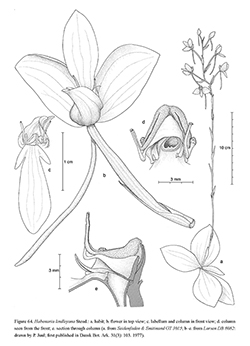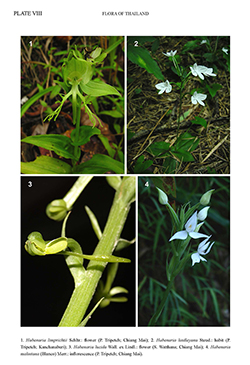e-Flora of Thailand
Volume 12 > Part 1 > Year 2011 > Page 117 > Orchidaceae > Habenaria
23. Habenaria lindleyana Steud.
Nomencl. Bot., ed. 2, 1: 717. 1840; Hook.f., Fl. Brit. India 6: 140. 1890; Seidenf. & Smitinand, Orchids Thail.: 41, 727. 1959–1965; Seidenf., Dansk Bot. Ark. 31(3): 101, fig. 61. 1977; Opera Bot. 114; 61, 1992; Kurzweil, Thai Forest Bull., Bot., special issue: 46. 2009. Fig. 64; Plate VIII: 2.
Accepted Name : This is currently accepted.
Synonyms & Citations :
Description : Flowering shoots glabrous, 15–50 cm tall. Foliage leaves 3–6, in a basal cluster on the ground, ovate, acute or acuminate, mucronate, 4.8–15 by (2.1–)3–8.5 cm. Sterile bracts 4–12, spreading or erect, lanceolate, acute or acuminate, 1.4–3.5 cm long. Inflorescence semi-dense or lax, (2–)5- to 25-flowered; rachis (2–)5–15 cm long; floral bracts lanceolate, acuminate, 12–29 by 3–4(–6) mm. Flowers 1.5–2.55 cm in diameter, white with greenish spur; flowers fragrant. Sepals obtuse to subacute; dorsal sepal erect, elliptic-ovate, 7–10 by 3–7 mm; lateral sepals spreading, elongate-elliptic, 12–24 by 6–10.5 mm, upper surface sometimes with short scale-like hairs. Petals forming a hood with the dorsal sepal, triangular-oblong, acute, 7–11 by 1.7–3 mm. Labellum 13–25 mm long, 3-lobed from the base, with a low collar around the spur mouth, upper surface with short scale-like hairs; midlobe elliptic to ovate, 11–23 by 2.9–6 mm; side lobes subulate, 3–8 by 0.7–1.5 mm; spur cylindric, (25–)31–40 mm long, sometimes apically clavate. Column 3–4.5 mm long; anther loculi diverging, anther canals 3–6 mm long, geniculately upwards-angled; stigmas 3–4 mm long. Ovary (including pedicel) (22–)25–34 mm long. Capsule not seen.
Thailand : NORTHERN: Chiang Mai, Chiang Rai, Nan, Lamphun, Lampang, Phrae, Tak, Nakhon Sawan; NORTH-EASTERN: Phetchabun, Loei; EASTERN: Nakhon Ratchasima; SOUTH-WESTERN: Uthai Thani, Kanchanaburi, Ratchaburi, Prachuap Khiri Khan; CENTRAL: Lop Buri, Saraburi; SOUTH-EASTERN: Chon Buri, Chanthaburi; PENINSULAR: unlocalised.
Distribution : Laos, Vietnam.
Ecology : In humid or dry soil in seasonal evergreen forests, deciduous forests, pine forests and bamboo forests over sandstone, granite, shale and limestone, also recorded in disturbed sites; 10–900 m alt. Flowering: mainly August–October.
Vernacular : Wan khao nieo (ว่านข้าวเหนียว), nang ua noi (นางอั้วน้อย)(Saraburi); ueang din (เอื้องดิน)(Central, Northern); nang krai (นางกราย), nang krai tua phu (นางกรายตัวผู้); nang tai tua phu (นางตายตัวผู้), ueang dok het khon (เอื้องดอกเห็ดโคน), nang tai noi (นางตายน้อย)(Loei); prao dok (เปราะดอก)(Kanchanaburi).
Notes: Collections, doubtfully of this species, were also made in Chaiyaphum Province in eastern Thailand.
As pointed out by Hooker (1890–1894: 140), Lindley’s type locality ‘Sri Lanka’ is certainly incorrect. It is now believed that the type specimen may have been collected somewhere around Bangkok, Thailand (Seidenfaden 1977: 102).


